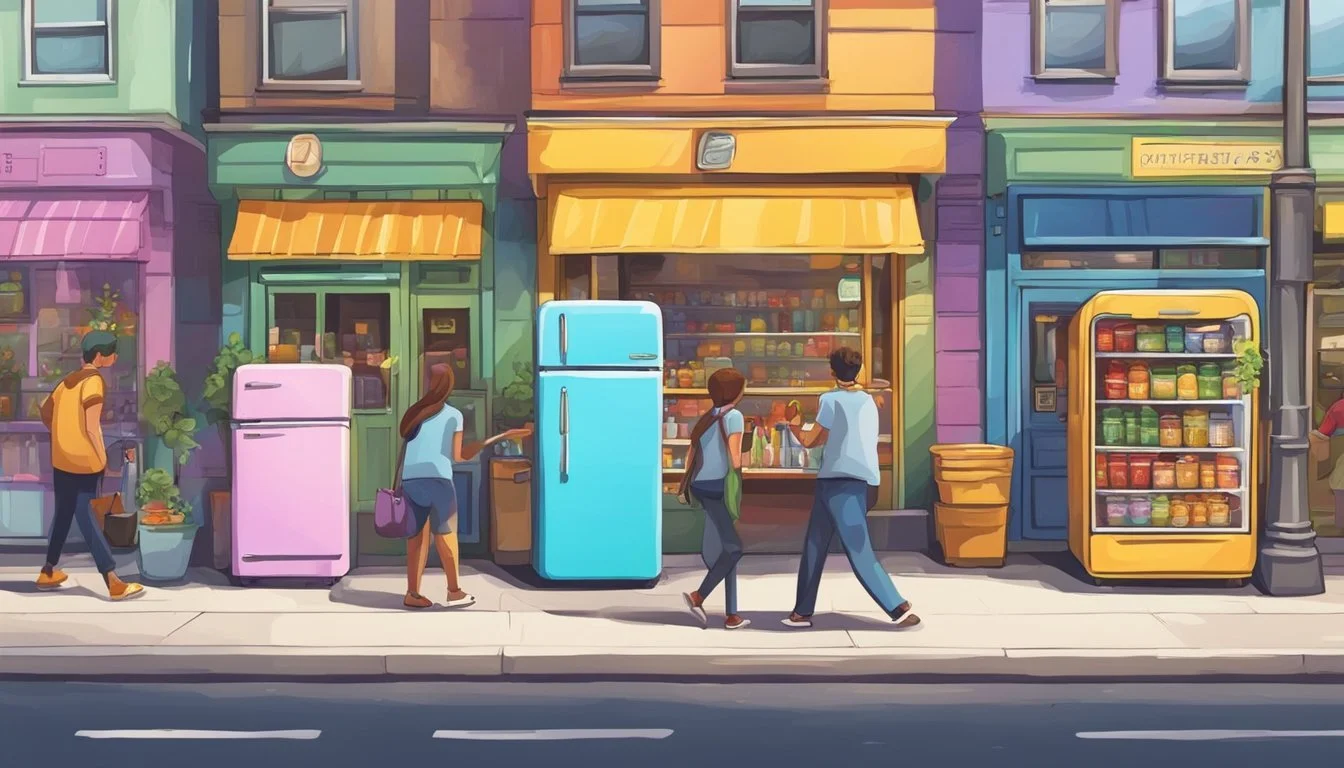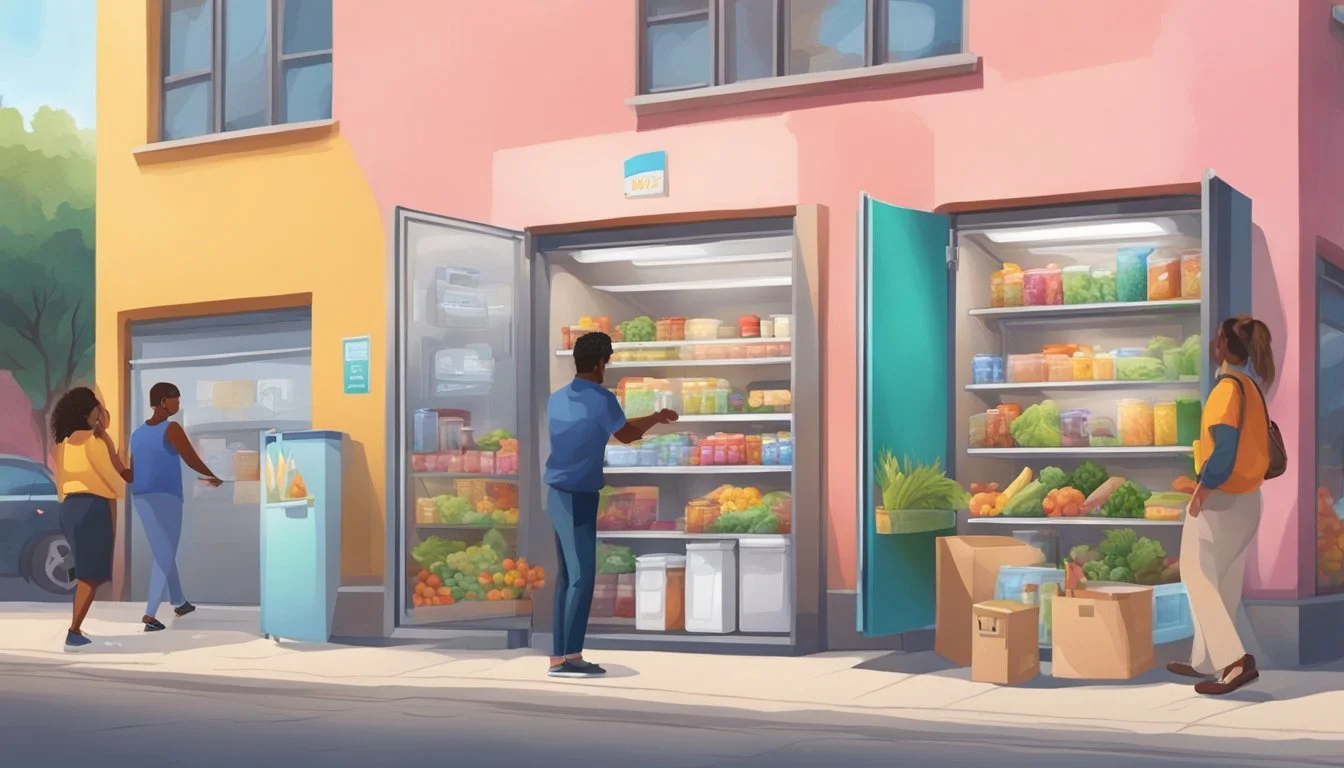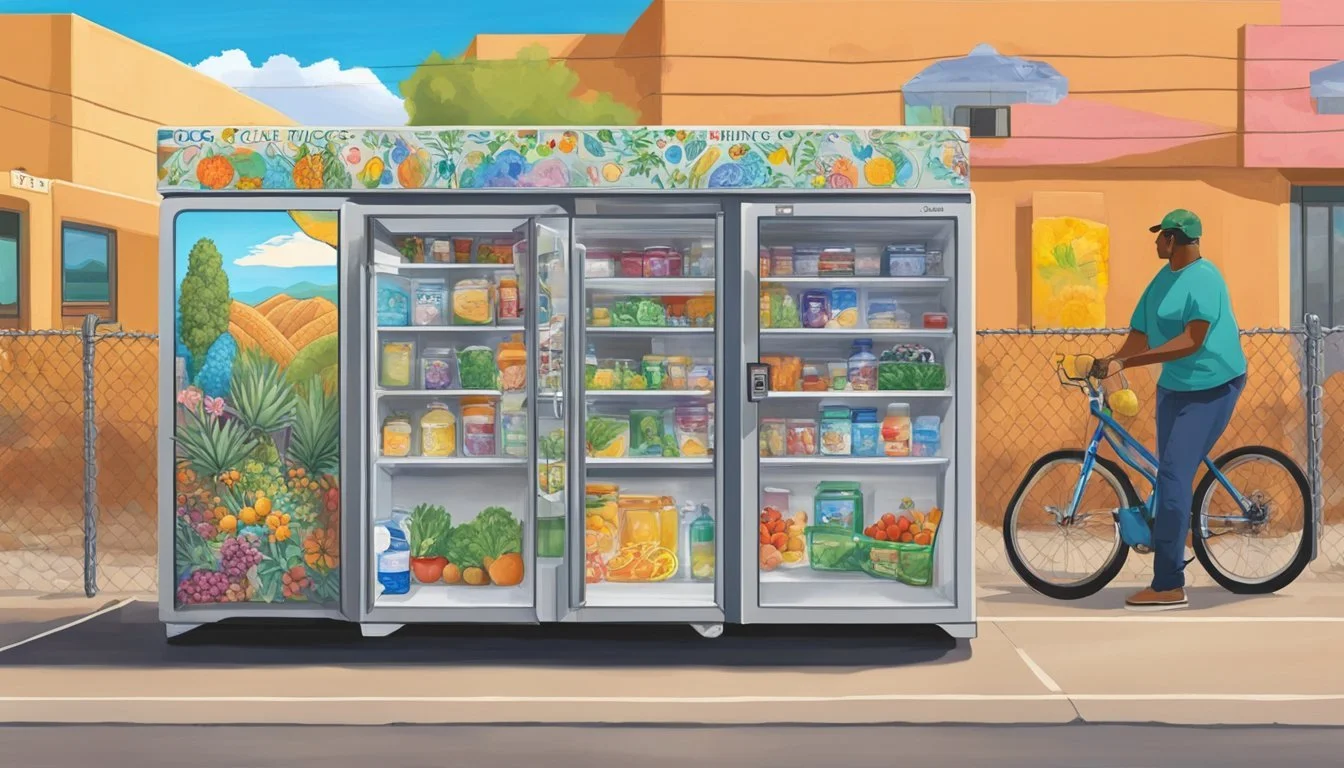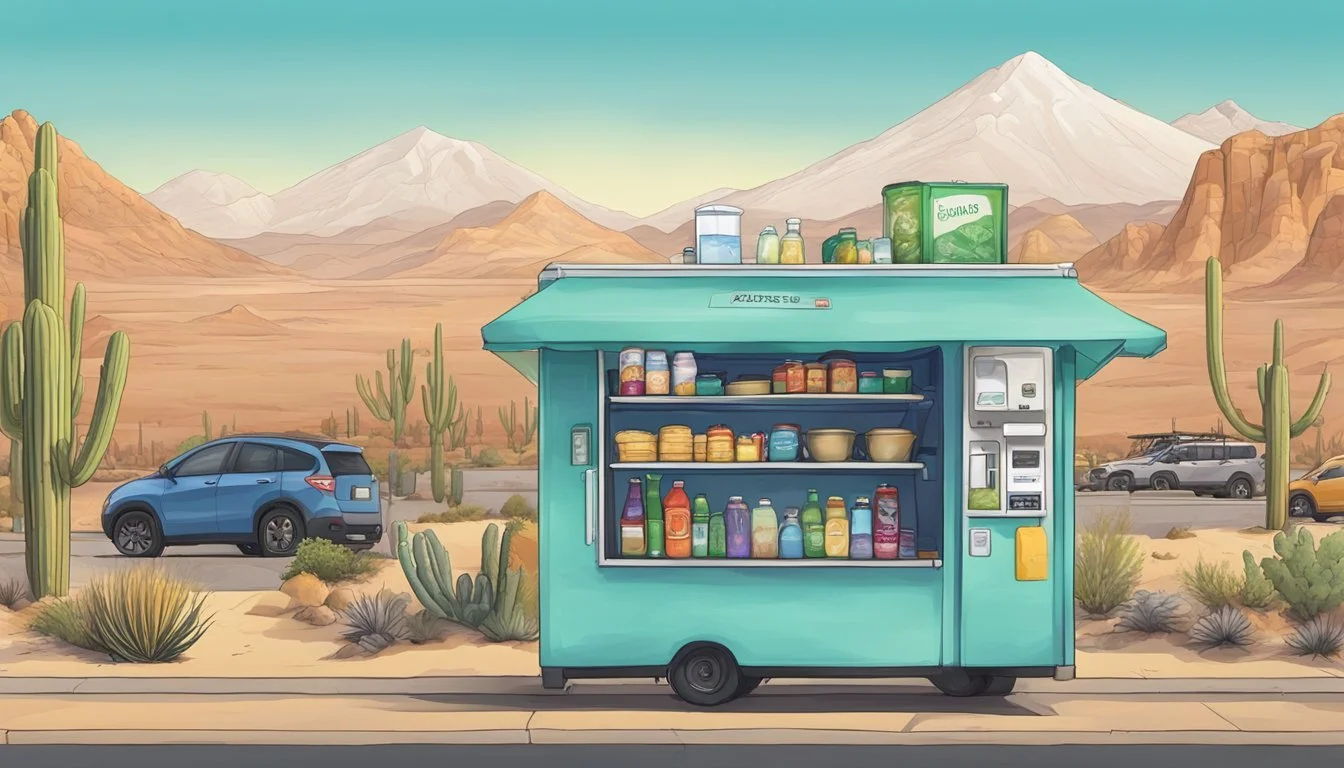Las Cruces, NM Community Fridge
Battling Food Insecurity Together
In the heart of the Land of Enchantment, Las Cruces, New Mexico, has added a fresh chapter to its ongoing narrative of community support and climate consciousness. Pioneering a project that addresses food insecurity while also taking a stand on environmental issues, the community fridge initiative in Las Cruces stands as a testament to the city's commitment to its residents. These fridges, accessible to everyone, help in providing fresh, nutritious food free of charge, fostering a spirit of sharing and caring in the local populace.
The concept of community fridges is not new, yet, in Las Cruces, it has been embraced with open arms as a direct response to the challenges exacerbated by the 2020 pandemic. Rising food prices and the disruption of supply chains led communities across the United States to seek out more decentralized, immediate means of aid. Las Cruces has taken up that call, demonstrating that a small act like sharing surplus food can make a significant impact.
While these refrigerators dot the streets of Las Cruces and provide sustenance, they do more than stave off hunger; they also represent a sustainable effort in reducing food waste. The city's engagement with the community fridge program reflects a dual achievement: residents are not only fed, but food that would otherwise be discarded finds a new home, thus reducing the carbon footprint associated with waste. This initiative illustrates how Las Cruces lives up to being part of the Land of Enchantment, enchanting not only through its scenic beauty but through the strength and adaptability of its community.
History and Culture
In Las Cruces, NM, the intertwining of history and culture demonstrates a community that values both its past and its present contributions, particularly in the unique context of the Chihuahuan Desert.
Historical Overview
Las Cruces, known as "The City of the Crosses," sits on the edge of the expansive Chihuahuan Desert. Founded in 1849 after the Mexican-American War, the city started as a humble patch of land south of the village of Doña Ana. Lieutenant Delos Bennett and his team of surveyors used rudimentary tools to carve out home lots, setting the foundational blocks of the now thriving community. This area has grown, yet it has preserved artifacts like the Las Cruces Railroad Museum, which stands as a testament to the transformative impact railroads had on Southern New Mexico.
Cultural Significance
The city's cultural fabric is rich and diverse, extending its reach into arts, festivals, and community initiatives like the Las Cruces Community Fridge. This community fridge stands not just as a symbol of the fight against hunger but also speaks to the collaborative and innovative spirit of the residents. Festivals throughout the year celebrate this synergy of history and present-day endeavors. They meld varied artistic expressions that echo through the downtown district, an area fervently supported by groups like the Doña Ana Arts Council and Downtown Las Cruces Partnership. These cultural manifestations are deeply rooted in the locale and represent the city's ongoing commitment to arts, sustainability, and community well-being within the larger Chihuahuan Desert environment.
Community Overview
In Las Cruces, NM, the establishment of community fridges serves as a testament to the town's commitment to addressing both hunger and environmental concerns. These resources reflect the collective ethos of a community geared towards inclusivity and sustainability.
Demographics
Las Cruces is a mosaic of cultural diversity, with a population that encompasses various ethnic backgrounds. The community is predominantly Hispanic or Latino, mirroring the rich cultural tapestry of New Mexico. Residents range from young professionals to retirees, cultivating a blend of traditions and modern lifestyles.
Population
According to recent data, the population of Las Cruces stands at approximately 103,000 residents. This figure includes a dynamic mix of individuals and families, with the city experiencing a steady growth rate. Las Cruces is characterized by its youthful energy, partly due to the presence of New Mexico State University, which contributes to the town's vibrancy and demographic makeup.
Education and Resources
In Las Cruces, New Mexico, the community benefits from a robust educational infrastructure that includes institutions like New Mexico State University, which provide ample resources and learning opportunities.
New Mexico State University
New Mexico State University (NMSU) is a key educational institution in Las Cruces. It offers a diverse range of programs and degrees, and it's known for its research activities and community engagement efforts, such as the Community Education program operated under its auspices. NMSU facilitates community enrichment through educational opportunities, engaging seniors in various classes, fitness activities, and recreational events.
Public Education
Public education in Las Cruces is supported by a network of schools delivering educational programs from elementary through high school. It ensures that students are well-prepared for higher education or the workforce. These schools collaborate with local organizations to offer additional learning resources and connect students with community initiatives like the Las Cruces Community Fridge, promoting practical learning experiences in community service and environmental stewardship.
Local Government and Services
Las Cruces provides a variety of essential services to the community, prioritizing sustainable waste management and offering supportive grant programs.
Waste Management and Recycling
The City of Las Cruces runs an Utilities Department that is dedicated to a variety of environmental services including waste management and recycling. They ensure the city has access to clean water, while responsibly handling wastewater treatment and solid waste disposal.
Water Supply: Regular provision to residents and businesses.
Wastewater: Collection, treatment, and environmental reintegration.
Solid Waste: Daily collection and disposal services.
In terms of recycling, the department emphasizes:
Curbside Recycling: Weekly pickup for household recyclables.
Special Waste: Safe disposal options for hazardous household waste.
The goal of these services is to maintain a healthy, sustainable environment for the residents of Las Cruces.
Grant Programs
The city has developed various grant programs to strengthen community services and support. Notable among these is the New Mexico Housing and Community Development Corporation, which facilitates a range of community enhancement projects through grants and other resources.
Important elements of this initiative include:
Housing Grants: Assistance for low-income families to secure housing.
Community Development: Funding for local projects that enrich the community's infrastructure.
These programs are designed to foster urban development and make Las Cruces a more livable city.
The Las Cruces Police Department is an integral part of the city's local government structure, contributing to public safety and security. They implement:
Policing Plans: Strategic planning for crime prevention and law enforcement.
Community Policing Grants: Funds allocated for programs that enhance police-community relations.
These services and programs represent Las Cruces's commitment to safety and community-building.
Employment and Economy
Las Cruces, NM, showcases a dynamic workforce and a growing economy affected by various factors like the cost of living and taxation. These factors significantly influence the area's employment trends and economic health.
Cost of Living
In Las Cruces, the cost of living is a critical factor that correlates with employment. Wages in the region are often measured against living expenses to gauge economic vitality. For instance, the housing market reflects a moderate cost level, which extends to utilities and groceries. Given these metrics, employees often weigh the affordability of living in Las Cruces against their earnings.
Housing: Moderately priced relative to national averages
Utilities: Comparable to statewide costs
Groceries: Affordable options available, influencing disposable income
Taxation
Taxation directly impacts both the disposable income of residents and the operational costs of businesses in Las Cruces. The tax structure includes:
Income Tax Rate: New Mexico operates a graduated income tax system, which can affect Las Cruces residents based on their income bracket.
Sales Tax Rate: Las Cruces has a combined sales tax rate that includes New Mexico state tax, Dona Ana County tax, and any city sales tax.
Tax Type Rate Income Tax Rate Graduated, varies by income bracket Sales Tax Rate 8.3125% (State + County + City combined)
These tax rates play a role in determining the net income of individuals and influence business decisions, which in turn affects the local economy. Businesses must navigate these taxation policies, which may impact job creation and economic expansion.
Safety and Crime
In the context of Las Cruces, NM, the safety of residents and visitors is a prioritized aspect, marked by a unique balance of crime statistics indicative of regional security trends and the committed presence of law enforcement.
Crime Overview
Las Cruces Crime Data at a Glance:
Crime Rate: 51.81 incidents per 1,000 residents in a typical year.
National Context: Las Cruces rests in the 73rd percentile for safety; thus, 27% of cities rank as safer, indicating a crime rate higher than the national median.
The city experiences diverse crime dynamics, reflecting both challenges and reassuring safety parameters for its population. Crimes in Las Cruces span property and violent offenses, with a noted need for continued vigilance and preventive measures.
Police and Community Programs
Las Cruces Police Department (LCPD) Initiatives:
Proactive Policing: The LCPD employs strategies aimed at the reduction of crimes through visibility and community engagement.
Community Programs: Various outreach efforts, such as neighborhood watches and youth programs, are designed to bridge the gap between the police and the community, fostering a collaborative environment for safety.
These programs serve as foundational efforts in crime prevention and community support, leveraging police resources to enhance the communal quality of life. Such initiatives highlight a proactive stance against crime, indicative of an earnest commitment to public safety.
Recreation and Entertainment
Las Cruces, New Mexico, offers a rich tapestry of recreation and entertainment options ranging from engaging arts and culture to a host of outdoor activities set against the backdrop of the stunning Organ Mountain.
Arts and Entertainment
Las Cruces is home to a vibrant arts scene, with numerous galleries showcasing local artists. Performances at venues like the Rio Grande Theatre provide a stage for both community and touring productions. The city's annual Renaissance ArtsFaire brings to life a historic atmosphere filled with artists, performers, and craftsmen.
Local Galleries: Strong focus on Southwestern art.
Performing Arts: The Rio Grande Theatre hosts various events throughout the year.
Parks and Outdoor Activities
Residents and visitors can enjoy the outdoors at numerous parks and recreational facilities. The city's Parks & Recreation Department facilitates adult athletic leagues and fitness classes, while the Spring Youth Sportsmanship Basketball League offers opportunities for younger residents. The scenic Organ Mountains serve as a breathtaking backdrop for activities like hiking, providing captivating sunsets and views.
Parks: Enhanced by a range of amenities for community use.
Outdoor Activities: Hiking in the Organ Mountains.
Scenic Views: Unforgettable sunsets against the Organ Mountains.
Climate and Environment
Las Cruces, New Mexico is characterized by its unique climate and rich natural landscapes. This section examines the city's semi-arid climate patterns and its location amidst the Chihuahuan Desert and the iconic Organ Mountains.
Local Climate
Las Cruces enjoys a semi-arid climate, typified by mild, dry winters and hot summers. On average, the city is bathed in sunshine for approximately 310 days each year. Temperature extremes are a feature of this desert climate, with historic highs reaching over 105°F. Notably, the year 2020 saw Las Cruces experience an unprecedented five weeks of extreme heat. Precipitation is relatively low, with the annual average around 8 inches, predominantly falling in the late summer.
Season Average High Temperature Precipitation Winter 69°F Low Summer 95°F Moderate
Natural Landscapes
The city of Las Cruces is nestled in the heart of the Chihuahuan Desert, one of the largest deserts in North America. This vast desert landscape is a tapestry of biodiversity and geological formations. Directly east of the city, the majestic Organ Mountains rise sharply from the desert floor, providing a dramatic backdrop that has earned New Mexico the moniker, the "Land of Enchantment." The proximity to such landscapes highlights the intrinsic connection between the city's climate initiatives and the preservation of its surrounding environment.
Transportation and Infrastructure
Las Cruces, New Mexico, has made significant strides in enhancing its transportation systems and infrastructure to improve accessibility and ease traffic congestion, ensuring the community's needs are well-met.
Traffic and Transit Systems
The city's traffic management has prioritized efficiency and safety, with improvements ongoing to accommodate its growing population. Public transportation in Las Cruces includes bus services provided by the RoadRUNNER Transit, offering residents various routes to ensure smooth transit within the city. These services are essential for the sustainability of community resources such as the Las Cruces Community Fridge, as they enable accessible food sources for individuals without personal vehicles.
Key Transit Services:
Local bus routes
Paratransit services for eligible riders
Roadways and Accessibility
Roadways in Las Cruces have seen substantial enhancement, including significant projects to improve major thoroughfares. The I-25/University Avenue Interchange Improvements Project stands out as a key development, awarded an Envision Rating for sustainable infrastructure. This project, completed in 2021, not only upgraded the interchange but also increased the overall roadway efficiency, impacting the day-to-day transportation of residents and visitors alike.
Notable Infrastructure Improvements:
Expansion and upgrading of the I-25/University Avenue interchange
Installation of modern traffic signal systems for improved flow and safety
Accessibility has also been prioritized, with transportation investments focusing on making Las Cruces a city where infrastructure meets community needs, therefore enhancing the quality of life for its residents.
Living in Las Cruces
Las Cruces, New Mexico, provides residents with a unique living experience, characterized by its housing market, and various pros and cons that affect everyday life.
Housing Market
The housing market in Las Cruces is generally considered affordable. Median home prices in Las Cruces are lower than many parts of the United States, making homeownership more accessible for residents. The area's lower property tax rates also contribute to the affordability of housing.
Pros and Cons
Pros:
Low Cost of Living: Overall, Las Cruces offers a cost of living that is below the national average.
Low Stress Environment: The city is known for a relaxed lifestyle with less traffic congestion when compared to urban centers.
Scenic Location: Proximity to the Organ Mountains offers beautiful views and outdoor recreation opportunities.
Cons:
Employment Opportunities: There is a noted lack of specialized job openings, which might limit career options for some professionals.
Limited Nightlife and Dining: Residents may find fewer options for dining out and entertainment, especially diverse cuisine.
Geographical Isolation: Las Cruces is somewhat remote, situated far from larger metropolitan cities, which might affect the accessibility of certain services and amenities.












